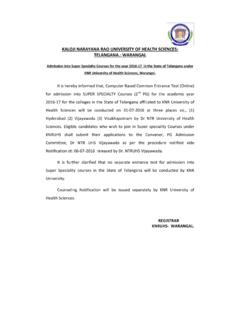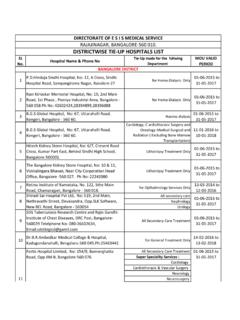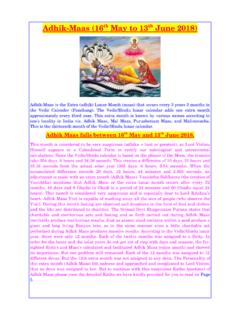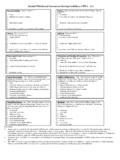Transcription of Effect of Tablet Surface Area and Surface Area/Volume on ...
1 Research Paper Effect of Tablet Surface Area and Surface Area/Volume on Drug release from lamivudine extended release matrix tablets P. narayana Raju*, K. Prakash, T. Rama Rao, Reddy, V. Sreenivasulu and M. Lakshmi Narasu KLR Pharmacy College, Khammam, India. ABSTRACT: The purpose of this study was to investigate the influence of Tablet Surface area/ volume (SA/Vol) on drug release from extended - release matrix tablets of lamivudine prepared with hydroxy propyl methylcellulose (HPMC). Highly soluble drug such as lamivudine was utilized in this study to give predominantly diffusion-controlled release . Drug release from HPMC matrix tablets with similar values of SA/Vol was comparable within the same Tablet shaped Tablet .
2 tablets having the same Surface area but different SA/Vol values did not result in similar drug release , tablets with larger SA/Vol values had faster release profiles. Utility of SA/Vol to affect drug release was demonstrated by changing drug doses, and altering Tablet shape to adjust SA/Vol. When SA/Vol was held constant, similar release profiles were obtained. Thus, Surface Area/Volume is one of the key variables in controlling drug release from HPMC matrix tablets . Proper use of this variable has practical application by formulators who may need to duplicate drug release profiles from tablets of different sizes and different shapes. KEYWORDS: Controlled release ; lamivudine matrix tablets ; HPMC; Surface area; Surface Area/Volume ratio Introduction In the formulation development, it is necessary to change the size, or shape of an existing product while maintaining the same release profile and also it is necessary to develop new strengths of the same dosage form .
3 One method to develop a new strength is by incorporating the excipients with increased or decreased concentration. Most of the formulations will be developed as dose proportional by increasing or decreasing the weight of the tablets . Even though it is dose proportional it is often difficult to maintain the similar release profiles in all the strengths. Similar release profile in all the strengths is a mandatory for USFDA to file ANDA. This is very difficult in case of developing the controlled release formulation. To overcome such problem it is always necessary to maintain some parameters such as shape, size, Surface area and Surface area/ volume as constant so that the optimum release profiles will be achieved.
4 Hydrophilic polymers, such as hydroxypropyl methylcellulose (HPMC), are commonly used as rate-controlling polymers for controlled drug release from matrix -type dosage forms. Controlled drug release from HPMC matrix tablets may be affected by several formulation variables, such as polymer level (Huber et al 1966., Lapidus etal 1966., Alderman etal 1984., Ford etal 1984, 1987) and molecular weight (Huber etal 1968), drug level and solubility (Colombo etal., 1996) , type of excipient (Ford etal 1987), and Tablet shape and size (Skoug etal., 1991, Laicher etal., 1995, Cheng etal., 1999, Karusulu et al., 2000, Siepmnan etal.)
5 , 2000). matrix geometry such as shape and size, affects the drug release for controlled- release dosage forms and several researchers reported the same (Karusulu et al., 2000). Specifically, the Effect of matrix geometry on drug release for HPMC matrix tablets has been studied in detail (Siepmann., 2000, Skoug., 1991). Siepmann et al. developed a mathematical model for diffusional drug release from HPMC matrices. In another study, Siepmann et al. examined the Effect of the aspect ratio (radius/ height) and the size of cylindrical matrices on drug release for diffusion-controlled systems. They stated that since small cylindrical tablets have a higher relative Surface area, , absolute Surface area/ absolute volume, the release from small tablets is faster than from large cylindrical tablets .
6 Skoug et al. 16 also reported that two halves of a sustained release Tablet had an increase in the Surface area to volume ratio (SA/Vol) of about 16% relative to whole tablets . This study demonstrated the effete of SA and SA/Vol on drug release of lamivudine form HPMC matrix tablets as a part of an ongoing project on the development of extended release formulations of lamivudine . International Journal of Pharmaceutical Sciences and Nanotechnology Volume 3 Issue 1 April June 2010 * For correspondence: P narayana Raju, E-mail: 872 P narayana Raju et al.: Effect of Tablet Area and Surface Area/ Volume on Drug release from .. 873 Materials and Methods Materials lamivudine (LAMI) was obtained as a gift sample from Alkem laboratories Ltd (Mumbai, India).
7 Hydroxypropyl methylcellulose of two grades (HPMC K 100 M and HPMC 874) were obtained from Colorcon Asia Private Ltd, lactose (Pharmatose DCL 21) was obtained form DMV International, Netherlands, Micro crystalline cellulose (Avicel PH 200) was obtained form FMC Biopolymers, USA, colloidal silicon dioxide (Aerosil) was obtained form Degussa, Germany, talc was obtained form Luzenac, France and magnesium stearate was obtained form Ferro Industrial Chemicals USA. All other chemicals and reagents used in the study were of analytical grade. Analytical method A validated UV Spectrophotometric method was used for the determination of lamivudine using Schimadzu, UV-1700 E 23 in pH phosphate buffer at 271 nm.
8 Formulation of lamivudine matrix tablets In the present study the matrix tablets were prepared using HPMC as the release retarding polymer. The tablets were manufactured by the direct compression. The drug, polymer(s) and all other excipients were sifted through 425 m sieve (ASTM mesh no 40) and mixed uniformly. The dry mix blend was then pre lubricated with aerosil and talc. The pre lubricated blend then lubricated with magnesium stearate. The lubricated blend was characterized for drug content. The lubricated blend was directly compressed on 16-station Tablet compression machine using different punches. (Cadmach Machinery Co, Ahmedabad, India). Three batches were prepared for each formulation and compressed 100 tablets form each batch for the characterization study.
9 Surface area and Volume calculations The formulation in the present study was selected based on the in vitro dissolution study of ongoing project. The tablets were compressed with different size round flat faced punches. The formulation components summarized in the table 1 Tablet Surface area (SA) and volume (Vol) were determined for each Tablet by measuring Tablet band thickness. The measured Tablet thickness was used in tooling specific equations to calculate the Tablet Surface area and volume. The following equations were used to calculate the Surface area and volume for the flat faced round tablets (46) SA = 2 r (r + t) ..(1) SA/Vol = 2 (r + t) / r t ..(2) Where r is the radius of the Tablet and t is the band thickness of the Tablet .
10 The matrix tablets prepared with HPMC K 100 M were used in this study. Table 1 Formulation components of lamivudine HPMC K100M matrix tablets . lamivudine 200 HPMC K 100 M 50 Pharmatose DCL 21 15 Micro crystalline cellulose (AVICEL PH 200) 20 Aerosil 6 Talc 4 Magnesium stearate 5 Drug content (% ) Hardness (kg/cm2) ( ) Thickness (mm) Friability (%) < In vitro drug release studies The in vitro dissolution studies were performed up to 14 hours using USP type I dissolution apparatus (LABINDIA, DISSO-2000, Mumbai, India) at 100 rpm.


![naray[apein;t [Narayana Upanishad] - Sri Sathya Sai ...](/cache/preview/d/1/7/a/9/5/5/1/thumb-d17a955126a2cbcde7afada490b74453.jpg)

![naray[sU´m [Narayana Suktam] Introduction](/cache/preview/2/c/f/7/f/6/4/f/thumb-2cf7f64f54385035062820f105924f4c.jpg)



